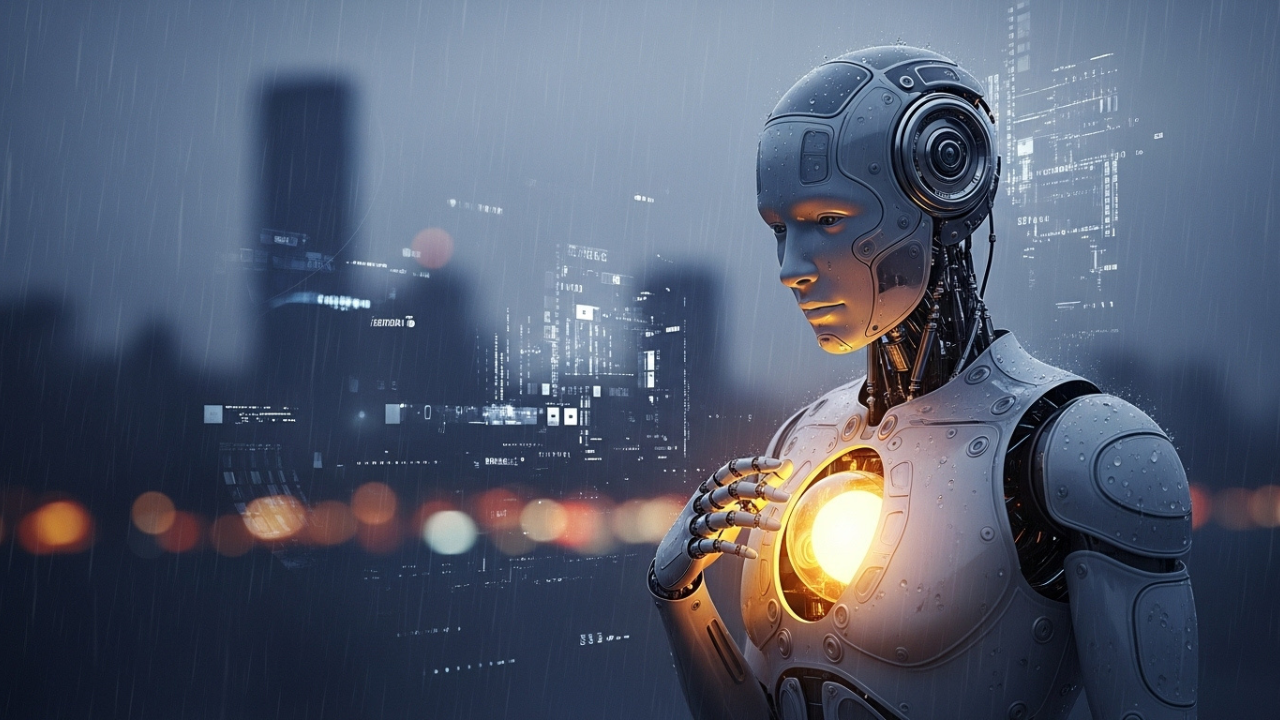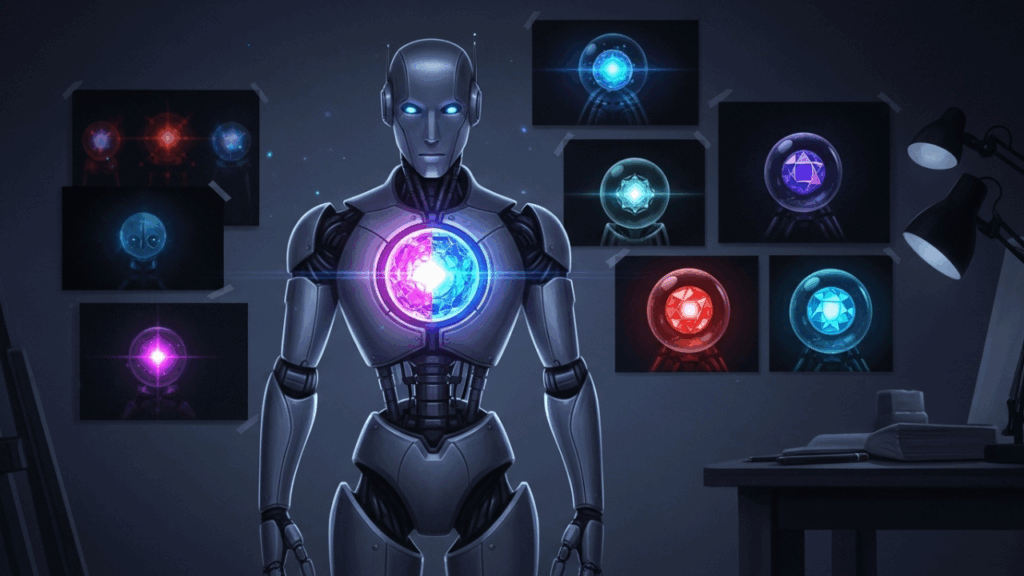Gazing into the eyes of a robot arouses a certain emotionally evoked depth in science fiction.
Seeing them on a screen or in a poster, one can feel that odd sense of a possibility that the machine can understand more than what it is made for.
It is strange yet beautiful when the cold hard metal tries to emulates warmth and feeling. Artists and writers often return to this idea of a “soul capsule” which is the center of the mystery.
If you have seen illustrations depicting a robot with a glowing core within its chest or a heart-like structure with a crystal levitating in its place, then you are well familiar with the concept.
In this piece I hope to explain what that symbol represents outside of a technical approach.
As I take you on this visual exploration, I hope to explain why the term ‘soul capsule’ is recurrent, what it reveals regarding human emotions and how it portrays deeper realities beyond robots and technology.
Key Takeaways
- The robot soul capsule depicts emotion engraved inside of machines.
- Sci-fi artists portray it to humanize technology.
- Its meaning shifts in different cultures and across art styles.
- The concept aids to analyze memory, identity as well as consciousness.
- And it reveals our profound desire to search for significance within technology.
From Wires to Wonder: The Soul Capsule Takes Shape
The notion of a soul imprisoned within a machine has not emerged spontaneously. It is the culmination of decades of narratives that gradually advanced the perception of machines from mere tools to something more sophisticated. Early science fiction films completely ignored the idea of soul capsules. Robots were nothing but laborers. They walked, they lifted, they obeyed. But the moment writers began asking, “What if it thinks? What if it remembers?” a shift occurred.
Consider a scene from a black-and-white classic: A robot rescues a child. However, instead of proceeding with a set movement, the robot halts and regards its hand—the one that previously clasped the child. That fraction of a second is so rich in meaning. It is pondering, what am I? That is the point where creators started to construct an imaginary core within the robot that would house those thoughts. Hence, the capsule emerged—not as a piece of machinery, but as a metaphor for consciousness.
How Visual Artists Gave Robots a Pulse
Illustrators in particular began depicting robots as having visual cores. They added small orbs, which usually glowed, to the chest area—nowhere else but the center where we humans associate emotion. Sometimes the capsule was crystalline or lit up. At other times, it resembled a mechanical heart, beating rhythmically.
Those decisions were not only aesthetic. They were instruments of narrative. They motivated the audience to think— if only for an instant—that perhaps there was something more happening beneath the surface of that metallic exterior. And once that illusion was formed, it enabled creators to examine profound issues solely with form and hue.
Culture Shapes the Capsule: East vs West
Whether you are an artist or a designer, or whether you are simply trying to make sense of the images itself, it’s crucial to note that the soul capsule is a cultural mirror. In the Western traditions, the soul is something often thought of as uniquely human—eternal, untouchable, and spiritual. However, in the Eastern worldview, especially in Shinto or animist traditions, the spirit is not limited to human beings. It exists in many other things.
Tools, rivers, trees, and stones can all carry spirit. That perspective also embraces the notion that a machine might possess a soul. This is the reason why there tends to be a difference in the portrayal of robots in anime compared to Western sci-fi. In anime, robots can serve as guardians, companions, or even lovers.
Their soul capsules glow warmly and often pulse with organic colors. In Western media, the glow is colder, more clinical, and often a source of tension. That difference in symbolism stems from culture, not just design.
Capsules That Tell Stories Without Words
This assists your understanding as a creator or viewer. It gives an idea of what narrative is being conveyed in imagery well ahead of dialogue. When a soul capsule is depicted as being removed, transferred, or destroyed, it is not simply powering down the robot. It conveys something sacred is being lost. It is death, erasure of memories, or emotional betrayal. In other narratives, re-lighting or restoration of a capsule enacts rebirth in their perspective too.
These effects are not arbitrary; they are visuals that resonate with genuine human emotions. The capsule telling a viewer that, robot or not, “this being matters” is telling them something meaningful.
Why the Capsule Still Works Today
It is captivating to consider that artists have used the same symbolic language time and time again, regardless of changing styles. Be it hand-drawn or AI-generated, minimalist or hyper-detailed, the capsule endures and captures attention.
Audiences will fixate on the gentle orb at center of a robot’s chest even amidst tumultuous battle scenes or radiant cityscapes. We are fundamentally inclined to search for hearts. So, while the soul capsule serves as a feature, it also acts as a lighthouse. It signals to the audience, “There is something here worth caring about.”
Two Robots, One Symbol: The Power of Visual Contrast
Bringing this into the tangible, consider the digital artwork depicting a humanoid robot crouched in the rain. Its chest is opened, and a soft glow emanates from a core . The warm light starkly contrasts a muted color palette. It is not dramatic, but quiet. In that moment, the viewer understands the robot is experiencing something. No backstory is needed. That light alone narrates the tale.
Now juxtapose that with perhaps the image of a giant mech suit in space with the core glowing icy blue. It emanates power rather than emotion. The capsule here radiates strength and possibly a threatening aura. Even so, both images lean on the same central symbol, differing only in situational context. This demonstrates the true power of the soul capsule: its versatility. It can be tuned emotionally like how a musician shifts a chord from major to minor.
The Age of AI and the Return of Soul Symbols
Why does this symbol capture the imagination of artists and audiences alike, especially in contemporary society? Perhaps because the world around us is filled with learning, talking, and responsive machines. We currently reside in an era where artificial intelligence composes poems, creates paintings, and engages in dialogues.
As these machines become increasingly sophisticated, we revisit the age-old questions: “What constitutes life? What defines reality?” The soul capsule grants form to that mystery and suggests a potential juncture where soul and code converge. The reason the symbol persists is precisely because it remains relevant—and indeed, it is more so now than ever.
Even AI Art Knows the Capsule by Heart
The emergence of AI-generated art adds a new layer AI-generated artworks also creates a spine-tingling illusion of human-like robots. And without the slightest consideration, guess what they’re inserting? The glowing core. The capsule. Visual storytelling is so deeply ingrained that even machines attempting to create art replicate it. This demonstrates that the symbol is no longer only a passing fad. It has taken on a mythic quality.
For Creators: How to Use the Capsule with Meaning
If you’re a creator hoping to use this symbol in your own work, there is something important to note. The issue at hand is not retaining a glowing heart and labeling it profound. The central question is what particular emotion are you attempting to evoke in the viewer? Is your robot hopeful, broken, peaceful, angry, or reborn?
A flickering red gem is not the same as a bright golden orb. A floating capsule is not the same as one buried deep inside a chest. And if you wish to move someone to the core, show the capsule dimming or reigniting. That change, though small, can hold more emotional significance than an entire page worth of conversation.
The Symbol That Won’t Go Away
The potential interpretations of this symbol are limitless. In the context of evolving robotics technologies and increasingly public discussions about machine consciousness, the soul capsule could acquire new meanings. Perhaps it can be a form of visual protest. Maybe it can serve as a religious metaphor. Or perhaps, in some distant future, robots will request artists to depict them with a capsule as a token of acknowledgment. Sounds utterly improbable, but so did talking computers a few decades ago.
The increasing digitization of the world around us intensifies the yearning for markers of humanity. We seek the illumination within the apparatus. We desire to trust there is a heart beneath the algorithm. And once more sci-fi art, via the soul capsule, offers us that possibility. It allows us to contemplate what it means to experience—evem in systems that, on a purely technical level, cannot.
My Opinion
As a student of art, a science fiction devotee, or someone grappling with the trajectory of culture, you should take notice of this symbol. It is worth your consideration. Examine it in the context of a film, or a video game, or a book, or even in a digital gallery. Ask what the stem of its significance might be. I assure you it has far more to offer than mere representation. Rather, it depicts a dialogue between our contemporary self and the future.
Perhaps this capsule’s most profound secret serves as a machine’s reminder: we have no reason to believe they do not possess a soul, as long as it causes us to remember that we indeed do.
 RapTijd
RapTijd



